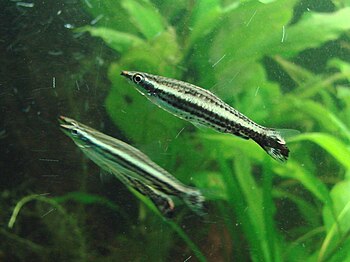 |
| Red Pencilfish (Nannostomus mortenthaleri) (Photo credit: Wikipedia) |
The Nannostomus varieties include the Eques, the Marginatus, the Unifasciatus, the Trifasciatus, and Beckfordi species. The Nannostomus Eques belongs from the Amazon region. These fish are widely known as the Nannobrycon Eque, or the Poecilobrycon. It is also called the tube fish and it can grow up to 2in. in length. The Pencilfish is yet another name for the variety. It has a long snout and it swims in the aquarium at angles. They are peace-loving creatures and do not like too many changes in their habitat. They prefer a water temperature of around 78 to 80 degrees Fahrenheit. The male of the species is generally slimmer than the female.
A. Nannostomus Marginatus
This is usually called the dwarfed Pencilfish. It belongs to western Guiana. They are quite small and do not grow more than about a quarter inch in length. But their colors make them look bigger than they really are. They have stripes of black and a sprinkle of red on the fins.
B. Nannostomus Unifasciatus
This one is also called the tail eye Pencilfish. Some people call it the One line Pencilfish. Its home is in the Amazon region. They grow to about 2in. length. These are some of the most colorful fish that you will ever come across. It has lower lobes, which are nicely colored with spots. When it enlarges its fins, it is a sight worth seeing.
C. Nannostomus Beckfordi
This fish is also a friendly creature much like it's cousins. It prefers water conditions similar to the other categories mentioned above. Whether it is good for breeding or not has not been determined yet. However, you could always make your own studies and research. It has widely come to be known as the Beckford's Pencilfish and also the Golden Pencilfish. It grows to around 1.75 inches and did this too belongs in the Amazon region. They are fragile fish and are great for the home aquarium.
Abhishek is an avid Fish Lover and he has got some great Aquarium Care Secrets up his sleeves! Article Source: EzineArticles |


